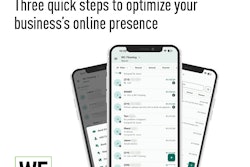

Recently I was talking with a wood floor business owner who had eight lead sources—Home Advisor, Houzz, Angie's List, Yelp, Facebook, etc. Combined, he was spending almost $4,000 a month.
But, because he wasn't tracking his lead-generation metrics, he had no idea which lead sources were working well and which ones were a waste of money. He was afraid to pull any of them for fear it was the source bringing in the most leads. Everything was based on a guess and a gut feeling.
What about you? Have you ever felt like you need to have multiple lead sources because everyone else seems to and you don't want to miss out? Have you ever felt afraid to pull the plug on a lead source because, while you have a gut feeling it's not profitable, you can't be 100 percent certain? This is a frustrating and expensive way of doing lead generation.
RELATED: How a Floor Pro Increased Profits Using 'Olympic Pricing' Estimates
If this is what you're currently doing in your business, allow me to share a better way. It's a simple system that will give you deep insight into each lead source and the confidence to know whether you should scrap it or stick with it and scale up.
How do we do that? By tracking metrics.
Why Tracking Metrics Is Important
If you knew for every dollar you spent on marketing, you would get $3, $4, $5 or $6 back as profit, how many dollars would you invest? If you knew a certain lead source was providing zero return for every dollar spent, how many dollars would you invest?
Insights like these are why successful business owners keep close track of their lead-generation metrics. When they know what works consistently, they ramp up the winners and profit handsomely. Just as important, when their analysis finds a dud, they scrap that lead source and move on. For every dollar they invest, they expect to gain X number of dollars back in profit.
Because of these insights, they can treat their lead-generation spend as a welcome investment rather than an unpleasant expense.
What Metrics Should Be Tracked?
There are eight important metrics that must be tracked and calculated so you can see whether your marketing efforts are producing a positive return on investment (ROI):
1. Lead-generation cost
2. Number of leads acquired
3. Average cost per lead
4. Number of clients acquired
5. Number of leads it takes to acquire a client
6. Your CAC (client acquisition cost)
7. Total sales generated
8. Your variable and fixed overhead costs (calculated either per period or per sale).
How to Calculate These Metrics
Yes, this means math, sorry. This is where some readers' eyes will start to glaze over. But for those willing to put in some effort, the rewards are great. Besides, it's not too difficult once you understand it. There are four steps. These are the calculations:
Step 1: Lead Generation Cost ÷ Number of Leads = Average Cost Per Lead
Step 2: Number of Leads ÷ Number of Clients = Number of Leads to Acquire Client
Step 3: Average Cost Per Lead x Leads to Acquire Client = CAC
Step 4: Total Sales ÷ Number of Clients - CAC - Overhead = Average ROI Per Lead
Let's have a look at a scenario and go through the calculations together for a 12-month period so we can see how it works. For this example, we'll use SEO-driven leads to our website as the lead source. We'll keep the figures simple so they're easy to follow.
Let's say our investment for an SEO expert to get us on page one of the search engines and keep us there is $2,000/month x 12 months = $24,000. Over the last 12 months we have acquired 320 leads from this source, and out of that we gained 160 clients. The gross value of all those projects was $1,000,000.
Step 1: Figure out our average cost per lead: $24,000 lead cost ÷ 320 leads = $75 per lead
Step 2: Discover the amount of leads it takes to obtain a client: 320 leads ÷ 160 clients = 2 leads to acquire a client
Step 3: Calculate our CAC (client acquisition cost): $75 average cost per lead x 2 leads to acquire a client = $150 CAC
Now we can finalize our calculation to figure out our ROI. We know total sales are $1,000,000, we had 160 clients, a CAC of $150 and, for the sake of simplicity, let's say our fixed and variable overhead costs are running at 60 percent per sale.
Step 4: Figure out our average ROI per lead. The calculations are: $1,000,000 ÷ 160 clients = $6,250 – $150 CAC – $3,750 overhead = average ROI of $2,350 per lead
You will need to do these same calculations for each lead source.
What Are Your Metrics Telling You?
Once you know your ROI for each of your lead-generation types, you can compare them side-by-side and see which are providing the best ROI.
The winners will be clear and obvious. There's no guessing, no fear, no gut feeling. Just plain hard facts and figures to base your decisions on.
Based on our fictitious example above of $150 CAC and ROI of $2,350 per lead, you can see how easy it would be to make some decisive moves and plans for future growth. Who wouldn't scale up a lead source like this? How many $150s would you spend for that size of return? On the other hand, if your calculations show a CAC of $450 and an ROI of $500, then it's just as obvious to drop that lead source and move on.
One Caveat
I should add one caveat to these calculations. If you have multiple sales from the same client—if you're a distributor, finish manufacturer or a floor refinisher chasing a prospect with multiple high-rise apartment complexes, etc.—you should add a ninth metric into the calculation: Lifetime Client Value, or LCV. Basically, LCV is the projected revenue you generate for the entire period they're your client. The initial sale may be $1,000, but over three years they're projected to spend $15,000 with you. With a higher lifetime ROI, you can afford to increase your CAC to gain the initial sale. This one-time investment will be balanced out over the subsequent transactions.
Tracking Solid Ground
If you don't know the ROI from your lead-generating efforts, you've put your business in a precarious situation. I strongly encourage you to start tracking your metrics. Stop basing your decisions on hope, guesswork, gut feelings and crossed fingers. Work out your ROI for each lead source using the calculations above. Yes, it will take some effort, but I guarantee you'll feel far more confident in the growth of your business when your lead generation efforts become well-calculated, insightful investments.
RELATED: What's the Best Business Advice You Ever Received?































